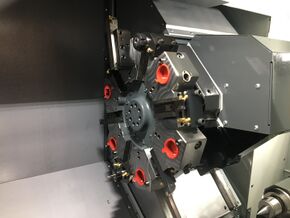Haas ST-15Y
 | |
| C-axis live tool CNC lathe. | |
| Equipment Information | |
|---|---|
| Status | Unknown |
| Manufacturer | Haas |
| Model | ST-15Y |
| Working Area | Ø240 mm x 400 mm |
| Maker Space Information | |
| Training Required | Yes |
| Training Information | Here |
In a lathe the material of the workpiece spins and the tool remains stationary - a piece of sintered tungsten carbide is then used to peel away material where it isn't wanted. If you need to produce parts which are primarily round this is the machine you should probably be using. This particular machine has a Y axis and live tooling capability which expands the possibilities even more by allowing work to take place off the spindle axis, and perpendicular to it as well.
Actually programming the machine is relatively easy using Fusion 360. We have a number of programming templates in the works which will automate the majority of the process. The (slight) difficulty is in the form of loading the tools in a manner that allows access to all of the work area without colliding with the chuck or another part of the machine enclosure.
Training
To book training on this machine please complete the training request form.
Programs for running the lathe are created within Fusion 360's Manufacturing workspace. If you are planning on using this machine it's recommended that you learn the basics of using the software before requesting training.
Power Up and Power Down
Power Up and Power Down (Haas ST-15Y)
You must warm up the spindle bearings if the machine has not been used in the last 24 hours. This is to ensure they are properly lubricated and ready for high loads.
Usage Information
Work Offsets
You need to tell the machine where the front face of the work is. Use the work offsets (usually G54) to set this.
Wear Offsets
Tool offsets are typically set by the automatic tool setter, but you may need to dial in normal wear and tear on the tool to achieve and maintain very accurate parts.
Threading
Excellent quality threads can be made on the lathe, but it is a little involved compared to simply running a tap through a hole. This page will guide you through some of the maths requried to create excellent threads using single-point cutting tools.
Making Accurate Parts
A lot of the time the part that comes straight off the machine is good enough - use the techniques here to help ensure your parts are in tolerance and to help with keeping the tighter tolerances in check.
Troubleshooting
A few issues crop up repeatedly. If you're having trouble with the lathe check this page to see if it's something we've come across before.
Workholding
Collets
The lathe usually has a collet chuck installed. This is an easy-to-use way to hold on to bar stock under 65mm in diameter. Check this page for how to change collets and order new sizes.
Hydraulic 3-jaw chuck
If you wish to work with a part or stock larger than 65mm you will need to use the hydraulic three-jaw chuck. This uses three jaws to hold on to stock, and can have custom machined "soft jaws" fitted to ensure an exceptionally good fit on both raw stock and finished surfaces.
Centres and Centre Drilling
Long work - more than 4 to 5 times their diameter - will need additional support when cutting. You can do this with with the hydraulically actuated tailstock and a live centre inserted into a specially drilled hole on the end of the bar.
Tailstock
You may need to use the tailstock to support long bars (as above, with a centre) It is a hybrid manual-hydraulic design which needs adjustment for each job.
Bar Puller
We have a cheap bar puller that can be programmed to automatically advance material so larger production runs can be somewhat automated. There is a small macro to simplify using the tool.

